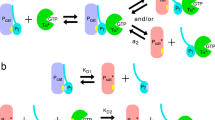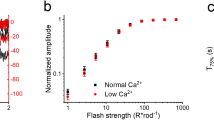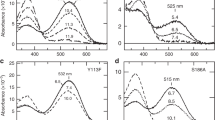Abstract
Photoreceptors detect light through a seven-helix receptor (rhodopsin) and heterotrimeric G protein (transducin) coupled to a cyclic GMP phosphodiesterase1,2. Similar pathways are used to amplify responses to hormones, taste and smell3,4,5. The amplification of phototransduction is reduced by a fall in cytoplasmic Ca2+ (refs 6, 7, 8, 9, 10), but it is not known how the deactivation of rhodopsin and transducin influence this response and hence the extent and duration of phosphodiesterase activity11,12,13,14. Here we investigate this by recording the electrical response to flashes of light in truncated rod photoreceptors10. By removing ATP to block the deactivation of rhodopsin by phosphorylation15, we show that this reaction limits the amplitude of the response and begins within 3.2 s of a flash in a solution containing 1 μM Ca2+, falling to 0.9 s in a zero-Ca2+ solution. In contrast, the activation and amplitude of the response were unaffected when transducin deactivation by GTP hydrolysis was blocked by replacing GTP with its non-hydrolysable analogue GTP-γS11, demonstrating that there is little GTP hydrolysis occurring over the period in which photoexcited rhodopsin is quenched. The rapid deactivation of rhodopsin is therefore a Ca2+-sensitive step controlling the amplitude of the light response, whereas transducin deactivation is slower and controls recovery.
This is a preview of subscription content, access via your institution
Access options
Subscribe to this journal
Receive 51 print issues and online access
$199.00 per year
only $3.90 per issue
Buy this article
- Purchase on Springer Link
- Instant access to full article PDF
Prices may be subject to local taxes which are calculated during checkout



Similar content being viewed by others
References
Stryer, L. The cyclic nucleotide cascade of vision. Annu. Rev. Neurosci. 9, 87–119 (1986).
Lagnado, L. & Baylor, D. Signal flow in visual transduction. Neuron 8, 995–1002 (1992).
Lamb, T. D. & Pugh, E. N. G-protein cascades: gain and kinetics. Trends Neurosci. 15, 291–298 (1992).
Kolesnikov, S. S. & Margolskee, R. F. Acyclic-nucleotide-suppressible conductance activated by transducin in taste cells. Nature 376, 85–88 (1995).
Gold, G. H. & Pugh, E. N. The nose leads the eye. Nature 385, 677–679 (1997).
Matthews, H. R., Murphy, R. L., Fain, G. L. & Lamb, T. D. Photoreceptor light adaptation is mediated by cytoplasmic calcium concentration. Nature 334, 67–69 (1988).
Nakatani, K. & Yau, K.-W. Calcium and light adaptation in retinal rods and cones. Nature 334, 69–71 (1988).
Kawamura, S. & Murakami, M. Calcium-dependent regulation of cyclic GMP phosphodiesterase by a protein from frog retinal rods. Nature 349, 420–423 (1991).
Kawamura, S. Rhodopsin phosphorylation as a mechanism of cyclic GMP phosphodiesterase regulation by S-modulin. Nature 362, 855–857 (1993).
Lagnado, L. & Baylor, D. A. Calcium controls light-triggered formation of catalytically active rhodopsin. Nature 367, 273–277 (1994).
Vuong, T. M. & Chabre, M. Deactivation kinetics of the transduction cascade of vision. Proc. Natl Acad. Sci. USA 88, 9813–9817 (1991).
Pepperberg, D. R. et al. Light-dependent delay in the falling phase of the retinal rod photoresponse. Vis. Neurosci. 8, 9–18 (1992).
Lyubarsky, A., Nikonov, S. & Pugh, E. N. The kinetics of inactivaction of the rod phototransduction cascade with constant Ca12+. J. Gen. Physiol. 107, 19–34 (1996).
Murnick, J. G. & Lamb, T. D. Kinetics of desensitisation induced by saturating flashes in toad and salamander rods. J. Physiol. (Lond.) 495, 1–13 (1996).
Wilden, U., Hall, S. W. & Kuhn, H. Phosphodiesterase activation by photoexcited rhodopsin is quenched when rhodopsin is phosphorylated and binds the intrinsic 48 kD protein of rod outer segments. Proc. Natl Acad. Sci. USA 83, 1174–1178 (1986).
Detwiler, P. B. & Gray-Keller, M. P. The mechanisms of vertebrate light adaptation: speeded recovery versus slowed activation. Curr. Opin. Neurobiol. 6, 440–444 (1996).
Chen, J., Makino, C. L., Peachey, N. S., Baylor, D. A. & Simon, M. I. Mechanisms of rhodopsin inactivation in vivo as revealed by a COOH-terminal truncation mutant. Science 267, 374–377 (1995).
Pepperberg, D. R., Jin, J. & Jones, G. J. Modulation of transduction gain in light adaptation of retinal rods. Vis. Neurosci. 11, 53–62 (1994).
Corson, D. W., Cornwall, M. C. & Pepperberg, D. R. Evidence for the prolonged photoactivated lifetime of an analogue visual pigment containing 11-cis 9-desmethylretinal. Vis. Neurosci. 11, 91–98 (1994).
Nikonov, S. S., Lyubarsky, A. L. & Pugh, E. N. Hydroylamine decreases rod sensitivity in situ without changing the dominant time constant of recovery. Invest. Ophthalmol. Vis. Sci. 37, S5 (1996).
McNaughton, P. A., Cervetto, L. & Nunn, B. J. Measurement of the intracellular free calcium concentration in salamander rods. Nature 322, 261–263 (1986).
Matthews, H. R. Static and dynamic actions of cytoplasmic Ca2+ in the adaptation of responses to saturating flashes in salamander rods. J. Physiol. (Lond.) 490, 1–15 (1996).
Lagnado, L., Cervetto, L. & McNaughton, P. A. Calcium homeostasis in the outer segments of retinal rods from the tiger salamander. J. Physiol. (Lond.) 455, 111–142 (1992).
Gray-Keller, M. P. & Detwiler, P. B. The calcium feedback signal in the phototransduction cascade of vertebrate rods. Neuron 13, 849–861 (1994).
Cervetto, L., Lagnado, L., Perry, R. J., Robinson, D. W. & McNaughton, P. A. Extrusion of calcium from rod outer segments is driven by both sodium and potassium gradients. Nature 337, 740–743 (1989).
Younger, J. P., McCarthy, S. T. & Owen, W. G. Modulation of the cytosolic free calcium and changes in sensitivity and circulating current occur over the same range of steady-state adapting lights in rod photoreceptors. Invest. Ophthalmol. Vis. Sci. 33, 1104 (1992).
Tanaka, T., Ames, J. B., Harvey, T. S., Stryer, L. & Ikura, M. Sequestration of the membrane-targeting myristoyl group of recoverin in the calcium-free state. Nature 376, 444–447 (1995).
Jones, G. J. Light adaptation and the rising phase of the flash photocurrent of salamander retinal rods. J. Physiol. (Lond.) 487, 441–451 (1995).
Gray-Keller, M. P. & Detwiler, P. B. Ca2+ dependence of dark- and light-adapted flash resonses in rod photoreceptors. Neuron 17, 323–331 (1996).
Sagoo, M. S. & Lagnado, L. Ca2+ increases the apparent affinity of transducin for GTP. Invest. Ophthalmol. Vis. Sci. 38, S614 (1997).
Acknowledgements
We thank C. Raeburn of the LMB Instrumentation Workshop for assistance. This work was supported by the HFSP. M.S.S. held a scholarship of the University of Cambridge M.B, Ph.D. Programme.
Author information
Authors and Affiliations
Corresponding author
Rights and permissions
About this article
Cite this article
Sagoo, M., Lagnado, L. G-protein deactivation is rate-limiting for shut-off of the phototransduction cascade. Nature 389, 392–395 (1997). https://doi.org/10.1038/38750
Received:
Accepted:
Issue Date:
DOI: https://doi.org/10.1038/38750
This article is cited by
-
The Probabilistic Cell: Implementation of a Probabilistic Inference by the Biochemical Mechanisms of Phototransduction
Acta Biotheoretica (2010)
-
Phototransduction in mouse rods and cones
Pflügers Archiv - European Journal of Physiology (2007)
-
PLC fills a GAP in G-protein-coupled signalling
Nature Cell Biology (2000)
-
Slowed recovery of rod photoresponse in mice lacking the GTPase accelerating protein RGS9-1
Nature (2000)
Comments
By submitting a comment you agree to abide by our Terms and Community Guidelines. If you find something abusive or that does not comply with our terms or guidelines please flag it as inappropriate.



